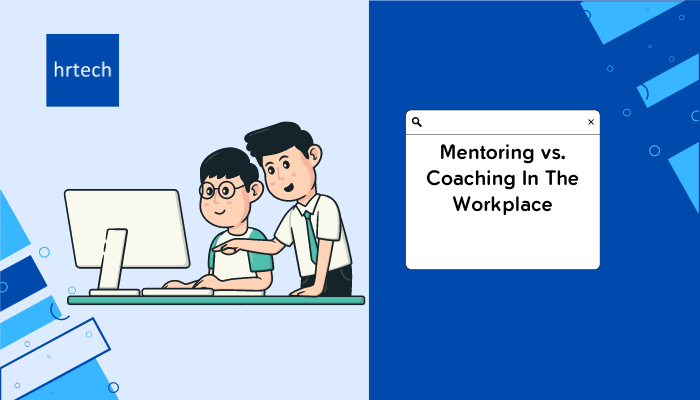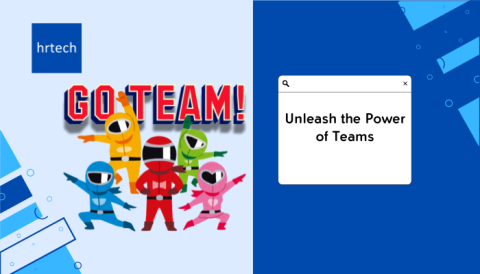Mentoring and coaching in the workplace are great ways to help employees grow and succeed. But while they may seem similar, there are some key differences between the two.
Read on till the end to find out the difference between mentoring vs. coaching, along with examples, benefits, pros, and cons of each.
Mentoring vs. Coaching In The Workplace
| Key Differences: | Mentoring: | Coaching: |
| Focus | Career development and personal growth | Specific skills or goals |
| Duration | Long-term | Short-term |
| Approach | Advice-giving | Question-asking |
| Relationship | Hierarchical | Equal partnership |
What Is Mentoring?
Mentoring is a relationship where a more experienced person (the mentor) guides and advises a less experienced person (the mentee). The mentor shares their knowledge, skills, and experience to help the mentee develop and grow.
Key characteristics of mentoring:
- Long-term relationship
- Focus on career development and personal growth
- Mentor provides advice and guidance
- Mentor is usually more senior or experienced
Types of mentoring:
- Formal mentoring – Structured program with assigned mentors and mentees
- Informal mentoring – Relationship develops naturally, without a formal program
- One-on-one mentoring – Mentor works with one mentee at a time
- Group mentoring – Mentor works with multiple mentees at once
What Is Coaching?
Coaching is a relationship where a coach helps an individual (the coachee) achieve specific goals or improve performance.
The coach asks questions and provides feedback to help the coachee find their own solutions.
Key characteristics of coaching:
- Short-term relationship
- Focus on specific skills or goals
- Coach asks questions and provides feedback
- Coach is not necessarily more senior or experienced
Types of coaching:
- Executive coaching – Helps leaders improve performance and achieve goals
- Performance coaching – Helps employees improve job performance
- Career coaching – Helps individuals navigate career transitions or advancement
Differences Between Mentoring And Coaching With Examples
While mentoring and coaching share some similarities, there are important differences between the two approaches. Here are some key points of distinction:
1. Focus
1. Mentoring:
Mentoring is focused on long-term career development and personal growth. Mentors help mentees navigate their career path, develop new skills, and build their professional network.
Example: A senior manager mentors a junior employee who aspires to move into a leadership role someday. The mentor provides guidance on the skills and experiences the mentee will need to achieve their long-term career goals.
2. Coaching:
Coaching is focused on achieving specific, short-term goals or improving performance in a particular area. Coaches help coachees identify areas for improvement and develop action plans to achieve their objectives.
Example: A sales representative works with a coach to improve their cold-calling skills and increase their conversion rate. The coach provides feedback and support as the rep implements new techniques and strategies.
Comparison:
Mentoring takes a broader, long-term view of an individual’s career development, while coaching is more targeted and focused on specific goals or challenges.
2. Duration
1. Mentoring:
Mentoring relationships are typically long-term, lasting several months to a year or more. Mentors and mentees meet regularly, but less frequently than in coaching relationships.
Example: A mentor and mentee meet once a month for a year to discuss the mentee’s progress and challenges.
2. Coaching:
Coaching relationships are typically short-term, lasting a few weeks to a few months. Coaches and coachees meet regularly, often weekly or bi-weekly, to discuss progress and next steps.
Example: A coach works with a coachee for three months to help them prepare for a major presentation.
Comparison:
Mentoring relationships are more extended and less intensive than coaching relationships, which are shorter and more focused.
3. Approach
1. Mentoring:
Mentors take an advice-giving approach, sharing their own experiences and knowledge to help mentees make decisions and solve problems.
Example: A mentor shares a story about a challenging project they led and the lessons they learned from the experience.
2. Coaching:
Coaches take a questioning approach, using powerful questions to help coachees generate their own insights and solutions.
Example: A coach asks a coachee, “What do you think is holding you back from achieving your goal?” and helps them explore their own thoughts and beliefs.
Comparison:
Mentoring has a more directive approach with the mentor providing guidance and advice. While coaching is more facilitative, with the coach supporting the coachee to find their own answers.
4. Structure
1. Mentoring:
Mentoring relationships are often informal and unstructured, with the mentor and mentee setting their own agenda and meeting schedule.
Example: A mentor and mentee meet for coffee once a month to catch up and discuss the mentee’s progress and challenges.
2. Coaching:
Coaching relationships are typically more structured, with regular meetings and a defined process for goal-setting, action planning, and progress tracking.
Example: A coach and coachee meet weekly for one-hour sessions, using a specific coaching framework to guide their conversations.
Comparison:
Mentoring is more flexible and adaptable to the needs of the mentor and mentee, while coaching follows a more structured and disciplined approach.
5. Qualifications
1. Mentoring:
Mentors are typically chosen based on their experience, knowledge, and willingness to share their expertise.
Example: A senior manager with 20 years of experience in the industry agrees to mentor a new employee.
2. Coaching:
Coaches are often trained and certified in specific coaching methods and techniques.
Example: A professional coach completes a rigorous certification program and receives ongoing supervision and development.
Comparison:
Mentoring relies on the mentor’s own qualifications and experience, while coaching requires specialized training and skills.
6. Communication
1. Mentoring:
Mentoring communication is often informal and conversational, with the mentor and mentee sharing stories and experiences.
Example: A mentor shares a personal anecdote about a challenging situation they faced and how they handled it.
2. Coaching:
Coaching communication is more structured and focused, with the coach using specific techniques such as active listening, powerful questioning, and direct feedback.
Example: A coach uses open-ended questions to help a coachee explore their own thoughts and feelings about a situation.
Comparison:
Mentoring communication is more relational and story-based, while coaching communication is more purposeful and technique-driven.
7. Relationship
1. Mentoring:
Mentoring relationships are hierarchical, with the mentor being more senior or experienced than the mentee.
Example: A senior executive mentors a mid-level manager in their department.
2. Coaching:
Coaching relationships are more equal, with the coach and coachee working together as partners.
Example: A coach works with a colleague to help them improve their time management skills.
Comparison:
Mentoring relationships are based on the mentor’s seniority and experience, while coaching relationships are based on the coach’s skills and ability to support the coachee’s growth.
8. Feedback
1. Mentoring:
Mentors provide feedback based on their own experiences and observations of the mentee’s performance.
Example: A mentor shares feedback on the mentee’s communication style based on their interactions in meetings.
2. Coaching:
Coaches provide feedback based on the coachee’s own insights and self-reflection, as well as observations of their behavior and performance.
Example: A coach reflects back to the coachee what they heard them say about their own strengths and weaknesses.
Comparison:
Mentoring feedback is based on the mentor’s experience and perspective, while coaching feedback is based on the coachee’s own insights and self-awareness.
9. Responsibility
1. Mentoring:
In mentoring, the mentee is responsible for their own learning and development, with the mentor providing guidance and support.
Example: A mentee takes the initiative to seek out new projects and opportunities to build their skills, and discusses their progress with their mentor.
2. Coaching:
In coaching, the coachee is responsible for taking action and making changes, with the coach providing support and accountability.
Example: A coachee commits to trying a new approach to a problem and reports back to the coach on their progress.
Comparison:
Both mentoring and coaching place responsibility on the individual being supported, but mentoring emphasizes the mentee’s own initiative, while coaching emphasizes the coachee’s accountability for taking action.
10. Activities
1. Mentoring:
Mentoring activities may include job shadowing, networking, and informal conversations.
Example: A mentor invites a mentee to attend a professional conference and introduces them to key team members.
2. Coaching:
Coaching activities may include role-playing, skill practice, and goal-setting exercises.
Example: A coach leads a coachee through a visualization exercise to help them prepare for a difficult conversation.
Comparison:
Mentoring activities are more varied and situational, while coaching activities are more structured and skill-based.
11. Evaluation
1. Mentoring: Mentoring relationships are typically not formally evaluated, although mentees may provide feedback to their mentors.
Example: A mentee shares with their mentor how much they have learned and grown through the mentoring relationship.
2. Coaching: Coaching relationships often involve formal evaluation and measurement of progress against goals.
Example: A coach and coachee set specific, measurable goals at the beginning of the coaching engagement and track progress over time.
Comparison:
Mentoring is less formal and structured than coaching, which often involves explicit goal-setting and evaluation of progress.
12. Training
1. Mentoring:
Mentors may receive some training on how to be effective in their role, but it is not always required.
Example: A company provides a half-day workshop for new mentors on active listening and providing feedback.
2. Coaching:
Coaches typically receive extensive training and may be certified by professional coaching organizations.
Example: A coach completes a 60-hour coaching certification program and receives ongoing professional development.
Comparison:
Coaching requires more specialized training and expertise than mentoring, which relies more on the mentor’s own experience and skills.
Mentoring vs. Coaching In The Workplace Pros And Cons
Pros And Cons Of Mentoring In The Workplace:
| Pros: | Cons: |
| Provides long-term career guidance and support | Requires significant time commitment from mentors |
| Helps develop a strong leadership pipeline | Matching mentors and mentees can be challenging |
| Improves employee engagement and retention | Mentoring relationships may not always be successful |
| Facilitates knowledge transfer and skill enhancement | Mentors may not have the necessary skills or training |
| Increases diversity and inclusion in the workplace | Mentoring programs can be difficult to scale |
Pros And Cons Of Coaching in the Workplace
| Pros: | Cons: |
| Focuses on specific skills and performance improvement | Coaching can be expensive, especially for external coaches |
| Provides targeted, actionable feedback and support | Coaching relationships are typically short-term |
| Enhances problem-solving and decision-making skills | Coaches may not have deep knowledge of the organization |
| Increases self-awareness and emotional intelligence | Coaching may not address broader career development needs |
| Improves leadership skills and change management | Coaching outcomes can be difficult to measure |
Benefits Of Mentoring And Coaching In The Workplace
Mentoring
- Career growth and development – Mentees can learn from their mentor’s experience and gain valuable insights into career advancement.
- Knowledge transfer and skill enhancement – Mentors can share their expertise and help mentees develop new skills.
- Improved employee engagement and retention – Mentoring programs can help employees feel more connected to the organization and more likely to stay.
- Stronger leadership pipeline – Mentoring can help identify and develop future leaders within the organization.
Coaching
- Improved performance and productivity – Coaching can help employees identify areas for improvement and develop action plans to achieve their goals.
- Enhanced problem-solving and decision-making skills – Coaches can help employees think through challenges and find effective solutions.
- Greater adaptability to change – Coaching can help employees develop the skills and mindset needed to navigate change and uncertainty.
- Increased self-awareness and emotional intelligence – Coaching can help employees better understand themselves and others, leading to improved communication and collaboration.
When To Use Mentoring vs. Coaching In The Workplace?
Mentoring is most effective when:
- An employee is new to the organization or role and needs guidance navigating the culture and expectations.
- An employee is looking to advance their career and needs advice on long-term development.
- The organization wants to build a strong leadership pipeline and develop future leaders.
Coaching is most effective when:
- An employee needs to improve specific skills or performance.
- An employee is facing a particular challenge or decision and needs help finding a solution.
- The organization is going through change and employees need support adapting.
In many situations, a combination of mentoring and coaching can be most effective. For example, an employee may have a mentor for long-term career guidance and a coach for specific skill development.
Implementing Mentoring And Coaching Programs
To create successful mentoring and coaching programs, follow these steps:
- Define the goals and objectives of the program
- Identify potential mentors and coaches within the organization
- Develop a matching process to pair mentors and coaches with their mentees and coachees. Consider skills, experience, and personality compatibility in this process.
- Provide training and support for mentors and coaches.
- Set expectations and guidelines for the mentoring or coaching relationship.
- Regularly check in and monitor progress.
- Measure the impact and ROI of mentor programs.
Frequently Asked Questions:
How To Find A Mentor Or Coach?
Start by looking within your organization for experienced leaders or colleagues who have the skills and knowledge you seek. You can also ask your manager or HR department about formal mentoring or coaching programs.
How Long Should A Mentoring Or Coaching Relationship Last?
Mentoring relationships are typically longer-term, lasting several months to a year or more. Coaching relationships are usually shorter-term, lasting a few weeks to a few months, depending on the specific goals.
What To Look For In A Mentor Or Coach?
Look for someone who has relevant experience, skills, and knowledge to share. Also consider personality compatibility and communication style to ensure a good fit.
How Often Should You Meet With A Mentor Or Coach?
The frequency of meetings will depend on the specific goals and needs of the mentoring or coaching relationship. In general, aim to meet at least once a month for mentoring and more frequently (weekly or bi-weekly) for coaching.
Final Thoughts
Mentoring and coaching are both valuable tools for supporting employee development and success in the workplace. While they share some similarities, there are important differences in focus, duration, approach, and relationship dynamics.
Mentoring is best for long-term career development and knowledge transfer, while coaching is best for improving specific skills and performance. Many organizations use a combination of both to support employees at different stages of their careers.
One of the best ways to encourage team growth and skill development is through training programs and courses. At hrtech, we offer top industry-leading HR courses and training programs. Visit hrtech now to learn more.





